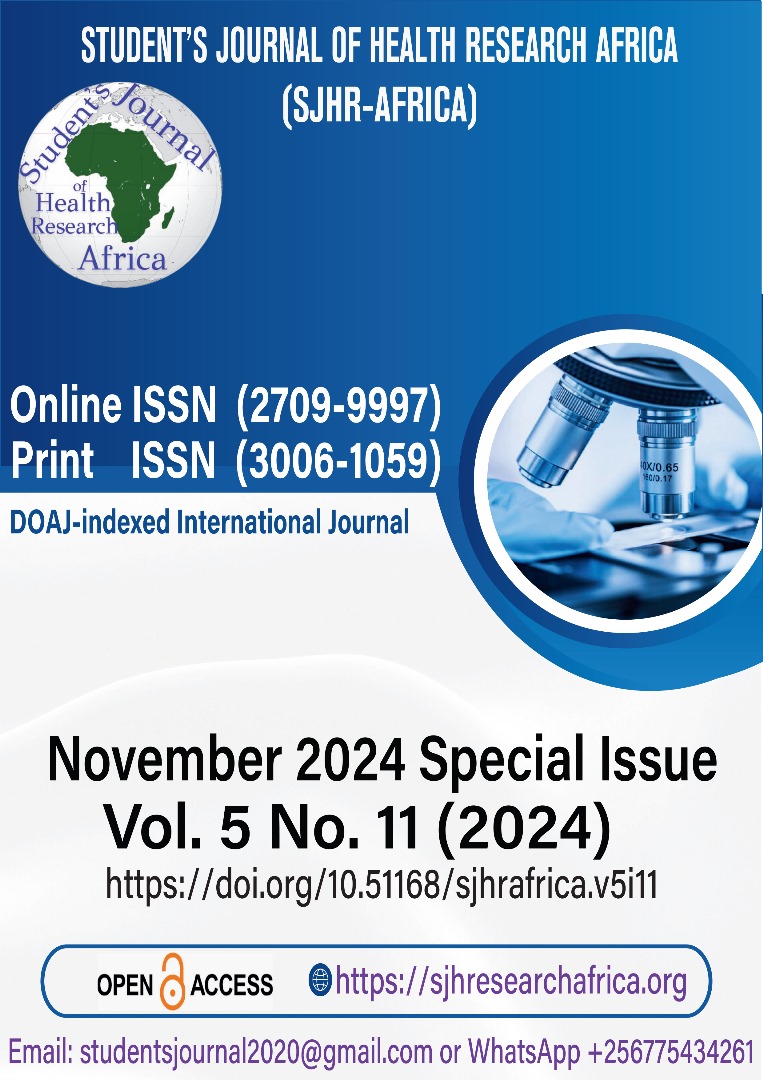REDUCTION IN SPINAL-INDUCED HYPOTENSION WITH ONDANSETRON IN PARTURIENTS UNDERGOING CAESAREAN SECTION.
DOI:
https://doi.org/10.51168/sjhrafrica.v5i11.1814Keywords:
Spinal anaesthesia, hypotension, ondansetron, caesarean section, parturients, vasopressors, maternal hemodynamicsAbstract
Background
Spinal anesthesia is the predominant technique utilized for caesarean sections, owing to its quick onset, straightforward administration, and efficacy.
Objective: The aim is to evaluate how well intravenous ondansetron reduces spinal-induced hypotension in parturients who underwent elective cesarean delivery under spinal anaesthesia.
Methods
Patna Medical College & Hospital conducted this prospective, randomized, double-blind trial over a 12-month period. Randomized into two groups (n=46 each), ninety-two ASA I/II parturients booked for elective lower segment cesarean delivery under spinal anesthesia were:
Group O (ondansetron group): Five minutes before spinal anesthesia, 8 mg of ondansetron intravenously.
Group C (Control group) received 10 mL of normal saline intravenuously.
Using 2 mL of 0.5% hyperbaric bupivacaine, all patients underwent spinal anesthesia. Baseline and consistent interval documentation of hemodynamic measurements—systolic blood pressure (SBP), diastolic blood pressure (DBP), mean arterial pressure (MAP), and heart rate (HR)—was recorded for thirty minutes following the block. There were reports of hypotension, vasopressors (ephedrine), and side effects included nausea and vomiting.
Results
The occurrence of hypotension was markedly reduced in Group O (26.1%) in contrast to Group C (63%). The ondansetron group required a much lower overall dose of ephedrine. Moreover, Group O saw a reduced incidence of intraoperative nausea and vomiting. The hemodynamic parameters exhibited greater stability in the ondansetron group during the monitoring period. No negative effects were observed in either group.
Conclusion
The prophylactic injection of intravenous ondansetron markedly diminishes the occurrence and intensity of spinal-induced hypotension in parturients having cesarean section. Its use also diminishes the necessity for vasopressors and enhances intraoperative mother comfort by alleviating nausea and vomiting. Ondansetron, a secure and easily accessible medication, may be regarded as a beneficial addition in the therapy of spontaneous intracranial hypotension during obstetric anesthesia.
References
Ali, A., Zafar, S., & Khan, R. M. (2018). Prophylactic use of ondansetron for the prevention of spinal-induced hypotension in elective cesarean section. Anesthesia, Essays and Researches, 12(1), 125-130.
El Sayed, H., Mahdy, A., & Abuelnaga, M. (2016). Effect of pre-spinal ondansetron on maternal hemodynamics and neonatal Apgar score during cesarean section. The Egyptian Journal of Anaesthesia, 32(4), 509-514.
Klöhr, S., Roth, R., Hofmann, T., Rossaint, R., & Heesen, M. (2010). Definitions of hypotension after spinal anesthesia for cesarean section: Literature review and application to parturients. Acta Anaesthesiologica Scandinavica, 54(8), 909-921. https://doi.org/10.1111/j.1399-6576.2010.02239.x PMid:20455872
Lee, A., Ngan Kee, W. D., & Gin, T. (2002). A quantitative, systematic review of randomized controlled trials of ephedrine vs phenylephrine for managing hypotension during spinal anesthesia for cesarean delivery. Anesthesia & Analgesia, 94(4), 920-926. https://doi.org/10.1097/00000539-200204000-00028 PMid:11916798
Liao, D. H., Lin, Y. P., & Lee, M. L. (2004). Incidence and risk factors for hypotension following spinal anesthesia in cesarean deliveries. Acta Anaesthesiologica Taiwanica, 42(2), 75-78.
Ngan Kee, W. D., Khaw, K. S., Lee, B. B., Lau, T. K., Gin, T., & Wong, E. L. (2005). A dose-response study of prophylactic intravenous ephedrine for the prevention of hypotension during spinal anesthesia for cesarean delivery. Anesthesia & Analgesia, 100(3), 789-794.
Ortiz-Gómez, J. R. (2012). Complications of spinal anesthesia in obstetrics. Current Opinion in Anaesthesiology, 25(3), 253-258.
Ortiz-Gómez, J. R., Palacio-Abizanda, F. J., Morillas-Ruiz, J. M., & Fornet-Ruiz, I. (2014). The use of ondansetron to reduce spinal-induced hypotension during cesarean section: A systematic review and meta-analysis. International Journal of Obstetric Anesthesia, 23(2), 138-143. https://doi.org/10.1016/j.ijoa.2014.01.005 PMid:24631057
Owczuk, R., Wenski, W., Twardowski, P., Sawicka, W., Dylczyk-Sommer, A., & Wujtewicz, M. (2008). Ondansetron attenuates the decrease in blood pressure due to spinal anesthesia. Anesthesia & Analgesia, 107(2), 511-514.
Rashad, M. M., & Farmawy, M. F. (2013). Prophylactic use of ondansetron for prevention of spinal anesthesia-induced hypotension in parturients undergoing elective cesarean section. Egyptian Journal of Anaesthesia, 29(4), 369-374. https://doi.org/10.1016/j.egja.2013.04.004
Sahoo, T., SenDasgupta, C., Goswami, A., & Hazra, A. (2012). Reduction in spinal-induced hypotension with ondansetron in parturients undergoing cesarean section: A prospective, randomized, double-blind study. International Journal of Obstetric Anesthesia, 21(1), 24-28. https://doi.org/10.1016/j.ijoa.2011.08.002 PMid:22100822
Saravanan, S., Kocarev, M., Wilson, R. C., Palin, C. A., Columb, M. O., & Lyons, G. (2006). Equivalent dose ratios of ephedrine and phenylephrine in the prevention of post-spinal hypotension. British Journal of Anaesthesia, 96(1), 95-99. https://doi.org/10.1093/bja/aei265 PMid:16311286
Stewart, A., Fernando, R., McDonald, S., Hignett, R., Jones, T., & Columb, M. (2010). The dose-dependent effects of phenylephrine for elective cesarean delivery under spinal anesthesia. Anesthesia & Analgesia, 111(5), 1230-1237. https://doi.org/10.1213/ANE.0b013e3181f2eae1 PMid:20841418
Trabelsi, W., Elaskri, H., Romdhani, C., & Ben Ammar, M. S. (2015). Prophylactic use of ondansetron in spinal anesthesia for cesarean delivery: Effects on maternal hemodynamics and neonatal outcomes. International Journal of Clinical Medicine, 6(8), 579-585. https://doi.org/10.1155/2015/158061 PMid:25648106 PMCid:PMC4306258
Wang, M., Zhu, Y., & Gu, X. (2015). The effect of ondansetron on the incidence of hypotension and bradycardia associated with spinal anesthesia: A meta-analysis. International Journal of Clinical and Experimental Medicine, 8(7), 10506-10514.
Downloads
Published
How to Cite
Issue
Section
License
Copyright (c) 2024 Neeraj, Niraj Kumar, Sudama Prasad, Rakesh Kumar

This work is licensed under a Creative Commons Attribution-NonCommercial-NoDerivatives 4.0 International License.






















